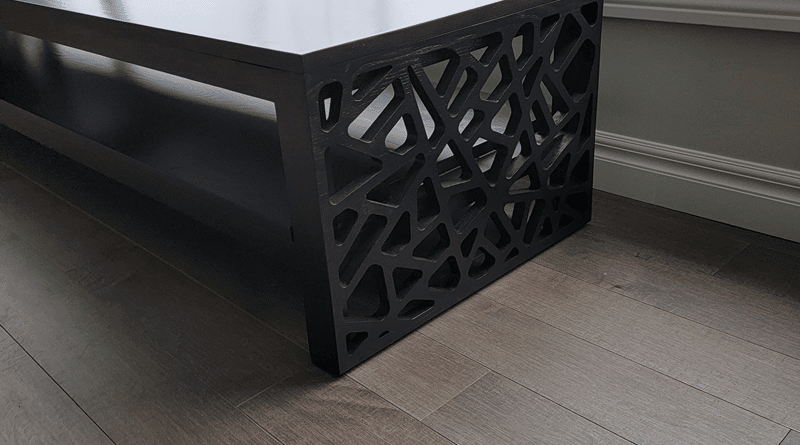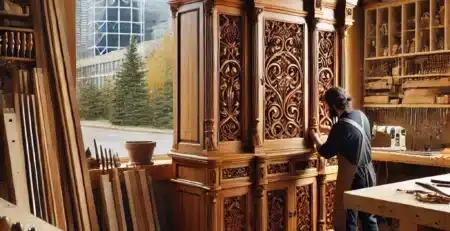The Importance of Craftsmanship in Custom Woodworking
In the words of the famous American woodworker, Sam Maloof, “When you work with your hands, your heart and your mind, you create something unique, something with a soul.” This quote captures the essence of handcrafted woodwork, emphasizing its timeless value and the unique touch that only skilled craftsmen can impart.
Skilled craftsmanship is the cornerstone of high-quality custom wood pieces, providing unmatched quality, durability, and aesthetic value. This essay explores the various facets of craftsmanship in woodworking, highlighting its significance, the intricate processes involved, the benefits it offers, and the challenges and rewards for those who dedicate their lives to this art.
Definition and Significance of Craftsmanship
Definition of Craftsmanship in Woodworking: Craftsmanship in woodworking involves a high level of skill, precision, and creativity in creating custom wood pieces. It requires a deep understanding of wood properties, tools, and techniques, allowing craftsmen to transform raw materials into functional and artistic items.
Historical Perspective on Craftsmanship: Historically, woodworking has been a revered skill, passed down through generations. From ancient Egyptian furniture to medieval European cabinetry, craftsmanship in woodworking has played a pivotal role in shaping cultures and histories. Artisans were highly regarded, their works considered valuable treasures due to their intricate details and quality.
Modern Relevance and Resurgence in Appreciation for Handcrafted Items: In today’s fast-paced, mass-produced world, there is a growing appreciation for handcrafted items. People are increasingly valuing the uniqueness, quality, and personal touch that custom woodworking offers. This resurgence reflects a desire to connect with tradition, artistry, and authenticity in a market flooded with generic products.
The Craftsmanship Process
Detailed Steps in the Custom Woodworking Process: The custom woodworking process is complex and requires meticulous attention to detail. It starts with a vision, transforming ideas into tangible designs, followed by careful material selection, precise cutting and shaping, and finally, the assembly and finishing of the piece.
Design and Planning: The initial phase involves conceptualizing the piece, sketching designs, and planning the project. This step is crucial as it sets the foundation for the entire process. Craftsmen collaborate with clients to understand their needs and preferences, ensuring the final product meets expectations.
Selection of Materials: Choosing the right wood is essential for quality and durability. Craftsmen select materials based on the project’s requirements, considering factors like grain pattern, hardness, and color. This step ensures that the wood’s natural beauty and characteristics are maximized in the final piece.
Precision in Cutting and Shaping: Precision is key in woodworking. Craftsmen use various tools and techniques to cut and shape the wood accurately. This stage demands a high level of skill and concentration, as even minor errors can affect the integrity and appearance of the final product.
Assembling and Finishing: The final stages involve assembling the cut pieces, joining them using techniques like dovetail or mortise and tenon joints, and applying finishes to enhance the wood’s natural beauty and protect it from damage. Each step requires patience and expertise, ensuring the piece is both functional and aesthetically pleasing.
Benefits of Skilled Craftsmanship
Quality and Durability of Custom Wood Pieces: Skilled craftsmanship ensures that custom wood pieces are of the highest quality and built to last. Craftsmen pay close attention to detail, using superior materials and techniques that enhance the strength and longevity of their creations.
Unique and Personalized Designs: One of the greatest benefits of custom woodworking is the ability to create unique, personalized designs. Craftsmen work closely with clients to incorporate their preferences and ideas, resulting in one-of-a-kind pieces that reflect personal style and taste.
Emotional and Aesthetic Value: Handcrafted wood pieces often carry significant emotional and aesthetic value. They are not just functional items but also works of art that evoke emotions and tell stories. The craftsmanship imbued in each piece adds a layer of meaning and connection that mass-produced items cannot replicate.
Example: A Story or Case Study: Consider the case of a custom-built dining table created for a family’s heirloom collection. The craftsman incorporated intricate carvings that reflected the family’s heritage and used reclaimed wood from their ancestral home. The result was a stunning piece that held deep sentimental value, serving as a centerpiece for family gatherings and storytelling.
Challenges and Rewards for Craftsmen
Common Challenges Faced by Craftsmen: Craftsmanship in woodworking is not without its challenges. Complex designs, material limitations, and the need for precision can make the process demanding. Craftsmen often spend hours perfecting their skills and finding innovative solutions to overcome these obstacles.
The Learning Curve and Dedication Required: Mastering woodworking requires dedication and a willingness to continuously learn and improve. The learning curve is steep, with many years of practice needed to achieve a high level of skill. Apprenticeships and mentorships play a crucial role in this journey, providing guidance and hands-on experience.
Personal and Professional Rewards: Despite the challenges, the rewards of being a skilled craftsman are immense. There is a deep sense of satisfaction and pride in creating something beautiful and enduring. Professionally, craftsmen can build a reputation for excellence, leading to a loyal customer base and opportunities to work on prestigious projects.
Examples of Professional Accomplishments: Many craftsmen find personal fulfillment in their work, seeing their creations become cherished possessions or centerpieces in homes and public spaces. They also enjoy the recognition and respect that come with mastering a traditional art form, contributing to the preservation of cultural heritage.
Craftsmanship vs. Mass Production
Comparison of Handcrafted Wood Pieces vs. Mass-Produced Items: Handcrafted wood pieces and mass-produced items differ significantly in quality, uniqueness, and value. While mass-produced items are cheaper and more readily available, they often lack the character, durability, and personal touch of handcrafted pieces.
Pros and Cons of Each: Mass-produced items offer convenience and affordability, making them accessible to a broader audience. However, they are often made from lower-quality materials and have shorter lifespans. In contrast, handcrafted pieces are more expensive and time-consuming to produce, but they offer superior quality, customization, and longevity.
Why Some Customers Prefer Handcrafted Pieces Despite Higher Costs: Many customers prefer handcrafted wood pieces despite their higher costs because they value the quality, uniqueness, and emotional connection these items provide. Handcrafted pieces often become heirlooms, passed down through generations, carrying stories and memories with them.
Supporting and Preserving Craftsmanship
Ways Consumers Can Support Skilled Craftsmen: Consumers can support skilled craftsmen by purchasing custom pieces, commissioning work, and spreading awareness about the value of craftsmanship. Buying handcrafted items not only ensures the survival of traditional skills but also supports local economies and sustainable practices.
The Role of Workshops and Apprenticeships in Preserving Craftsmanship Skills: Workshops and apprenticeships are vital for preserving craftsmanship skills. They provide aspiring craftsmen with hands-on training, mentorship, and the opportunity to learn from experienced artisans. These programs help keep traditional techniques alive and adapt them to modern contexts.
Importance of Educating the Next Generation of Craftsmen: Educating the next generation is crucial for the future of craftsmanship. Schools, community programs, and online resources can introduce young people to woodworking, inspiring them to pursue it as a hobby or career. Encouraging creativity, patience, and a love for hands-on work are essential steps in this process.
Conclusion
Skilled craftsmanship is integral to creating high-quality, unique, and emotionally significant wood pieces. It combines tradition, skill, and creativity, resulting in works of art that stand the test of time. Seek out handcrafted wood pieces, supporting artisans who dedicate their lives to preserving this timeless craft. By choosing custom woodwork, consumers contribute to the survival of traditional skills and the creation of beautiful, meaningful items.
The enduring legacy of skilled craftsmanship in woodworking is a testament to the human spirit’s creativity, dedication, and desire to create lasting beauty. Handcrafted wood pieces not only enrich our lives but also connect us to a rich heritage of artistry and skill.
As you consider adding unique and high-quality woodworking pieces to your home or office, look no further than The Original Workshop. Our artisans combine traditional craftsmanship with modern techniques to create stunning, durable, and personalized wood pieces that you won’t find anywhere else. By choosing The Original Workshop, you’re not just purchasing a piece of furniture; you’re investing in a work of art that embodies the dedication, skill, and passion of our craftsmen. Support the tradition of skilled woodworking and bring home a piece of timeless beauty from The Original Workshop today.












